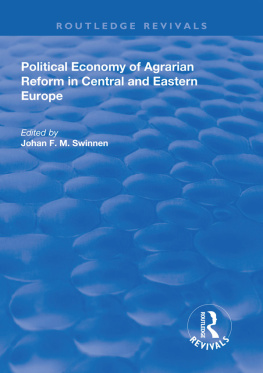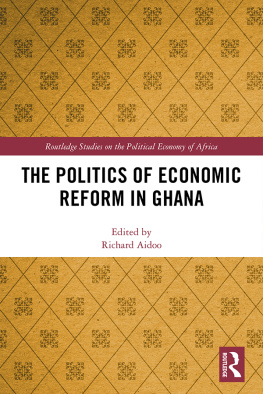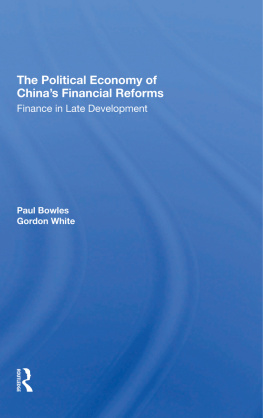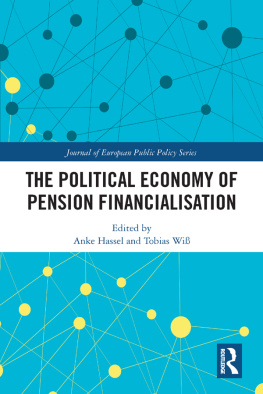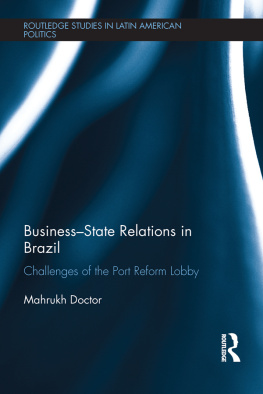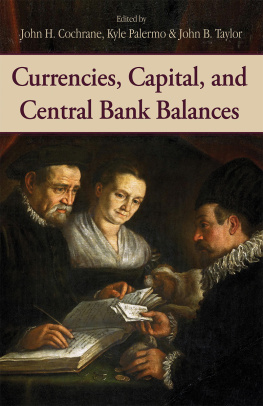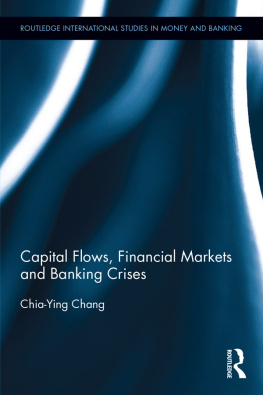THE POLITICAL ECONOMY OF MEXICO'S FINANCIAL REFORM
To all my friends
who chose to devote their professional careers to public affairs
The Political Economy of Mexicos Financial Reform
Osvaldo Santn Quiroz
Institute for Banks Savings Protection (Mexico)
First published 2001 by Ashgate Publishing
Reissued 2018 by Routledge
2 Park Square, Milton Park, Abingdon, Oxon OX14 4RN
711 Third Avenue, New York, NY 10017, USA
Routledge is an imprint of the Taylor & Francis Group, an informa business
Copyright Osvaldo Santn Quiroz 2001
All rights reserved. No part of this book may be reprinted or reproduced or utilised in any form or by any electronic, mechanical, or other means, now known or hereafter invented, including photocopying and recording, or in any information storage or retrieval system, without permission in writing from the publishers.
Notice:
Product or corporate names may be trademarks or registered trademarks, and are used only for identification and explanation without intent to infringe.
Publishers Note
The publisher has gone to great lengths to ensure the quality of this reprint but points out that some imperfections in the original copies may be apparent.
Disclaimer
The publisher has made every effort to trace copyright holders and welcomes correspondence from those they have been unable to contact.
A Library of Congress record exists under LC control number: 00111418
ISBN 13: 978-1-138-70372-8 (hbk)
ISBN 13: 978-1-315-20301-0 (ebk)
- ABM Asociacin de Banqueros de Mxico /Mexican Bankers Association
- AMCB Asociacin Mexicana de Casas de Bolsa /Mexican Association of Brokerage Houses
- BANACCI Grupo Financiero BANAMEX-ACCIVAL
- BANAMEX Banco Nacional de Mexico /National Bank of Mexico
- BANCOMER Banco de Comercio /Bank of Commerce
- BANCOMEXT Banco Nacional de Comercio Exterior /National Bank for External Trade
- BANOBRAS Banco Nacional de Obras Pblicas /National Bank for Public Works
- BANRURAL Banco Nacional de Credito Rural /National Bank for Rural Credit
- BdeM Banco de Mxico / Bank of Mexico (Mexico's Central Bank)
- BMV Bolsa Mexicana de Valores /Mexican Stock Exchange
- BNCI Banco Nacional de Comercio Interior /National Bank of Internal Trade
- BONDES Bonos para el Desarrollo /Bonds for Development
- CBA Central Bank Autonomy
- CCE Consejo Coordinador Empresarial /Entrepreneurial Coordinating Council
- CDB Comit de Desincorporacion Bancaria /Banking Divestiture Committee
- CETES Certificados de la Tesorera /Treasury Bills
- CNBV Comisin Nacional Bancaria y de Valores /National Commission for Banking and Securities
- FIRA Fideicomisos Instituidos en Relacin a la Agricultura /Trust Funds Instituted Regarding Agriculture
- FOBAPROA Fondo Bancario de Proteccin al Ahorro /Banking Fund for Savings Protection
- GDP Gross Domestic Product
- IMF International Monetary Fund
- ITAM Institute Tecnolgico Autnomo de Mxico / Autonomous Technological Institute of Mexico
- LDCs Less Developed Countries
- LGIC Ley General de Instituciones de Crdito /Credit Institutions General Act
- LOBdeM Ley Orgnica del Banco de Mxico /Banco de Mexico Organic Act
- Mex $ Mexican pesos
- MFOs Multilateral Financial Organisations
- NAFIN National Financiera /National Investment Bank
- NAFTA North American Free Trade Agreement
- PRD Partido de la Revolucin Democrtica /Party of the Democratic Revolution
- PRI Partido Revolucionario Institutional /Institutional Revolutionary Party
- PROBURSA Promotora Burstil, SA
- PRONASOL Programa National de Solidaridad /National Programme of Solidarity
- PSE Pacto de Solidaridad Economica /Economic Solidarity Pact
- SBH Stock Brokerage House
- SHCP Secretaria de Hacienda y Crdito Pblico /Ministry of Finance
- TELMEX Telfonos de Mxico
- TESOBONOS Bonos de la Tesorera /Treasury Bonds
Mexico's financial reform illustrates how President Carlos Salinas used 'structural adjustment' policies to engineer new bases of support for the regime and consequently to consolidate his political leadership within the new parameters set by economic globalisation and political democratisation. The main stimulus for Mexico's financial reform came from political imperatives as understood by President Salinas and his economic team. Economic reform, gradual democratisation, and social spending were all policies subordinated to the goals of reasserting presidential authority, government capacity and the PRI's electoral hegemony. Mexico's financial reform was the result of political entrepreneurial initiative la Meier (1991). The charismatic leadership of President Salinas aligned a powerful coalition of support for economic reform.
In each case of reform to the financial system, President Salinas used extensively the organisational and institutional infrastructure of the quasi-authoritarian Mexican state to overcome the legitimacy deficit inherited from the 1988 elections. President Salinas devoted an important part of the state's resources to gain popular support for the regime from the beginning of his term. His government was very well aware of political constraints. Largely for this reason, Salinas sought to boost the purchasing power of the peso, leading to an enormous increase in the current account deficit. President Salinas emphasised the need to provide a positive image of Mexico in foreign countries in order to attract investment and boost the economy.
Mexico's financial reform represents a case where President Salinas redefined the economic role of the state in order to reduce the state's exposure to economic swings and to increase state capacity. According to Jorge Dominguez (1987; 76), while good economic performance helps regimes and incumbents to generate legitimacy, poor performance serves to undermine legitimacy. Salinas sought to avoid potential conflict and to make new alliances with powerful groups, like financiers and large industrialists, by scaling down the economic activities of the state. His reform also intended to release state resources so they could be re-directed to strategic areas where the state could exercise more effective control upon society and the economy.
The political discourse during this period stressed the importance of improving state capacity to satisfy the needs of the poor. In his inaugural speech, President Salinas outlined this vision:
...the crisis has shown us that a larger state is not necessarily a more capable state; a state that owns more is not necessarily a state that is more just. The truth is, in Mexico, more state has meant less capacity to respond to the social needs of our fellow countrymen and, in the end, greater weakness of the state itself. All the time the activity of the public sector was increasing, attention to the problems of the highest social priority was decreasing (quoted by Golob 1997: 132).
According to Anne Krueger's (1974) 'pluralist' hypothesis, public policy is the result of competition between interest groups. In other words, organised interest groups push the government to introduce reforms. Considering Mexico's financial reform from her perspective, it follows that the coalition of interests that favoured the reform outweighed the coalition that opposed it. However, broader state priorities like regime legitimacy weighted more heavily than support from specific constituencies when the decision to reform the financial system was taken. The interest groups that benefited from the reforms, though powerful, did not have the capacity to subordinate the government's political agenda to their own private interests. In this case, the relevant groupsinternational and domestic capitaldisplayed considerable influence but the state still preserved the power to set the parameters for economic policy-making. For instance, President De la Madrid's financial policy favoured a new interest group organised around the stock exchange and the brokerage houses. Important policy decisions served the interests of this group like the sale of non-banking concerns after the nationalisation and the emission of government securities. However, these decisions responded in the first place to the financial needs of the state during the 'debt crisis'.


